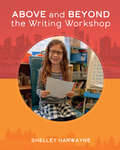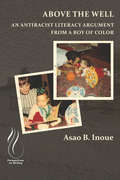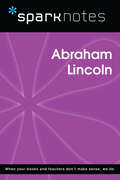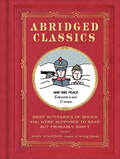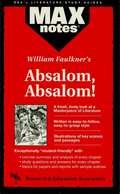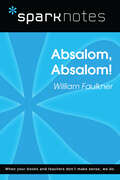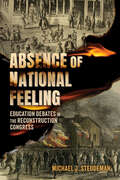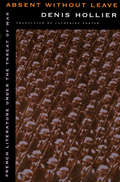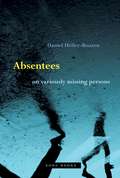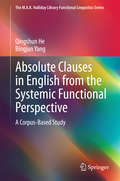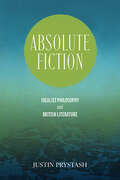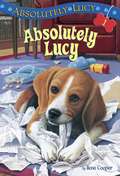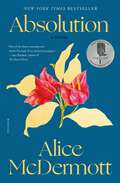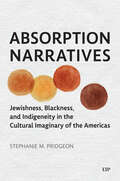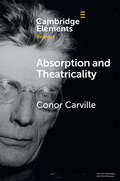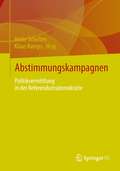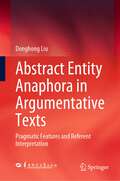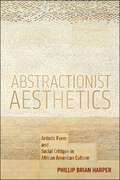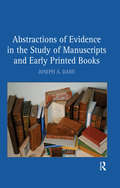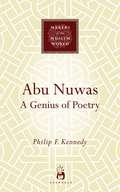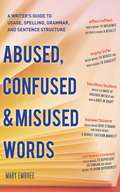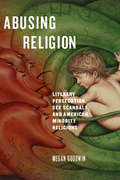- Table View
- List View
Aboutness (Carl G. Hempel Lecture Series #3)
by Stephen YabloAboutness has been studied from any number of angles. Brentano made it the defining feature of the mental. Phenomenologists try to pin down the aboutness-features of particular mental states. Materialists sometimes claim to have grounded aboutness in natural regularities. Attempts have even been made, in library science and information theory, to operationalize the notion. But it has played no real role in philosophical semantics. This is surprising; sentences have aboutness-properties if anything does. Aboutness is the first book to examine through a philosophical lens the role of subject matter in meaning. A long-standing tradition sees meaning as truth-conditions, to be specified by listing the scenarios in which a sentence is true. Nothing is said about the principle of selection--about what in a scenario gets it onto the list. Subject matter is the missing link here. A sentence is true because of how matters stand where its subject matter is concerned. Stephen Yablo maintains that this is not just a feature of subject matter, but its essence. One indicates what a sentence is about by mapping out logical space according to its changing ways of being true or false. The notion of content that results--directed content--is brought to bear on a range of philosophical topics, including ontology, verisimilitude, knowledge, loose talk, assertive content, and philosophical methodology. Written by one of today's leading philosophers, Aboutness represents a major advance in semantics and the philosophy of language.
Above and Beyond the Writing Workshop
by Shelley HarwayneWhen writing workshops first blossomed in classrooms, its hallmarks were genuine curiosity, individual choice, quality conversations, and engaging children's literature. A joyous hum of intention, creativity, and craft enlivened the school day. Today's teachers are often faced with a range of obstacles, as new initiatives are embraced, mandates handed down, and scripted programs are purchased. Sometimes teachers must sacrifice the original principles of the writing workshop and lose the creative venue they provide. Above and Beyond the Writing Workshop is filled with original writing challenges designed to bring back the spirit of the original writing workshop model and encourage teachers to enhance it with invention, innovation, and inspiration. Teaching creative writing is not only possible, but an important process in their instruction. Author Shelley Harwayne invites teachers to keep the workshop spirit alive by: Encouraging professional conversations on classroom ideas and methods between colleagues; Developing writing cues that allow young writers to be inquisitive, outspoken, and independent; Showing how high quality writing can make a difference; Offering an inspired and stimulating outlet for students to express their passions. Harwayne's book will help teachers encourage students to write the world around them, which can generate more critical thinking and make for a more well-rounded child.
Above the Well: An Antiracist Literacy Argument from a Boy of Color
by Asao B. InoueAbove the Well explores race, language and literacy education through a combination of scholarship, personal history, and even a bit of fiction. Inoue comes to terms with his own languaging practices in his upbring and schooling, while also arguing that there are racist aspects to English language standards promoted in schools and civic life. His discussion includes the ways students and everyone in society are judged by and through tacit racialized languaging, which he labels White language supremacy and contributes to racialized violence in the world today. Inoue’s exploration ranges a wide array of topics: His experiences as a child playing Dungeons and Dragons with his twin brother; considerations of Taoist and Western dialectic logics; the economics of race and place; tacit language race wars waged in classrooms with style guides like Strunk and White’s The Elements of Style; and the damaging Horatio Alger narratives for people of color.
Abraham Lincoln (SparkNotes Biography Guide)
by SparkNotesAbraham Lincoln (SparkNotes Biography Guide) Making the reading experience fun! SparkNotes Biography Guides examine the lives of historical luminaries, from Alexander the Great to Virginia Woolf. Each biography guide includes:An examination of the historical context in which the person livedA summary of the person&’s life and achievementsA glossary of important terms, people, and eventsAn in-depth look at the key epochs in the person&’s careerStudy questions and essay topicsA review testSuggestions for further readingWhether you&’re a student of history or just a student cramming for a history exam, SparkNotes Biography guides are a reliable, thorough, and readable resource.
Abridged Classics: Brief Summaries of Books You Were Supposed to Read but Probably Didn't
by John AtkinsonA collection of irreverent summations of more than 100 well-known works of literature, from Anna Karenina to Wuthering Heights, cleverly described in the fewest words possible and accompanied with funny color illustrations.Abridged Classics: Brief Summaries of Books You Were Supposed to Read but Probably Didn’t is packed with dozens of humorous super-condensed summations of some of the most famous works of literature from many of the world’s most revered authors, including William Shakespeare, Charles Dickens, Emily Brontë, Leo Tolstoy, Jane Austen, Mark Twain, J.R.R. Tolkien, Margaret Atwood, James Joyce, Plato, Ernest Hemingway, Dan Brown, Ayn Rand, and Herman Melville.From "Old ladies convince a guy to ruin Scotland" (Macbeth) to "Everyone is sad. It snows." (War and Peace), these clever, humorous synopses are sure to make book lovers smile.
Abroad: British Literary Traveling Between the Wars
by Paul FussellA book about the meaning of travel, about how important the topic has been for writers for two and a half centuries, and about how excellent the literature of travel happened to be in England and America in the 1920s and 30s.
Absalom, Absalom! (MAXNotes Literature Guides)
by Carol JohnsonREA's MAXnotes for William Faulkner's Absalom, Absalom! MAXnotes offer a fresh look at masterpieces of literature, presented in a lively and interesting fashion. Written by literary experts who currently teach the subject, MAXnotes will enhance your understanding and enjoyment of the work. MAXnotes are designed to stimulate independent thought about the literary work by raising various issues and thought-provoking ideas and questions. MAXnotes cover the essentials of what one should know about each work, including an overall summary, character lists, an explanation and discussion of the plot, the work's historical context, illustrations to convey the mood of the work, and a biography of the author. Each chapter is individually summarized and analyzed, and has study questions and answers.
Absalom, Absalom! (SparkNotes Literature Guide Series)
by SparkNotesAbsalom, Absalom! (SparkNotes Literature Guide) by William Faulkner Making the reading experience fun!Created by Harvard students for students everywhere, SparkNotes is a new breed of study guide: smarter, better, faster.Geared to what today's students need to know, SparkNotes provides:chapter-by-chapter analysisexplanations of key themes, motifs, and symbolsa review quiz and essay topicsLively and accessible, these guides are perfect for late-night studying and writing papers.
Absalom, Absalom: The Questioning of Fictions
by Robert Dale ParkerFrom the preface: "This study of Absalom, Absalom! is aimed at the full range of readers, from thoughtful beginners to scholarly specialists in Faulkner studies. Absalom, Absalom! Absalom, Absalom! is forever telling readers already familiar with its tale that they need to start over and look again and forever pressing those who are discovering it for the first time to plunge into whirlwinds of speculation usually reserved for experts. Thus this book is organized so that people can read the novel two or three chapters at a time and then read the corresponding section of this book in the same way a student might attend a class after being asked to read each quarter or so of a long novel."
Absence of National Feeling: Education Debates in the Reconstruction Congress (Race, Rhetoric, and Media Series)
by Michael J. SteudemanBefore the start of the Civil War, the US Congress seldom took up the question of education, deferring regularly to a tradition of local control. In the period after the war, however, education became a major concern of the federal government. Many members of Congress espoused the necessity of schooling to transform southern culture and behavior, secure civil rights, and reconstruct the Union. Absence of National Feeling: Education Debates in the Reconstruction Congress analyzes how policymakers cultivated a rhetoric of public education to negotiate conflicts over federalism and civic belonging in the aftermath of the Civil War. Reconstruction Era advocates embraced education as a way to orchestrate the affective life of Americans. They believed education could marshal feelings of hope, love, shame, and pride to alter Americans’ predispositions toward other citizens. The most assertive educational advocates believed that schools would physically bring together children divided by race or religion, fostering shared affinities and dissolving racial hierarchies. Schooling promised to be an emotional adhesive, holding together the North and South and facilitating US expansion into the West. Through protracted debates over national education funding, the fate of the Freedmen’s Bureau, and school desegregation, members of Congress negotiated schools’ potential as a vehicle for social change. By Reconstruction’s end, most members of Congress accepted schooling as an element of national reconciliation. To reach this tenuous consensus, though, legislators sacrificed their call for schools to intervene in the feelings of prejudice, resentment, and superiority that sustained the culture of slavery. Rejecting a transformative educational vision, Congress took another tragic step in its abandonment of Reconstruction. Focusing on the words spoken in the Reconstruction Congress, Absence of National Feeling contends that educational rhetoric appealed to legislators debating whether the federal government could, or even should, alter public feeling. Tracing congressional transcripts between 1865 and 1877, author Michael J. Steudeman illustrates that these debates lastingly helped to both define and delimit the possible trajectories of education policy.
Absent without Leave: French Literature under the Threat of War
by Denis HollierThey were not the "Banquet Years," those anxious wartime years when poets and novelists were made to feel embarrassed by their impulse to write literature. And yet it was the attitude of those writers and critics in the 1930s and 1940s that shaped French literature--the ideas of Derrida, Foucault, de Man, Deleuze, and Ricoeur--and has so profoundly influenced literary enterprise in the English-speaking world since 1968. This literary history, the prehistory of postmodernism, is what Denis Hollier recovers in his interlocking studies of the main figures of French literary life before the age of anxiety gave way to the era of existentialist commitment. Georges Bataille, Michel Leiris, Roger Caillois, André Malraux, the early Jean-Paul Sartre are the figures Hollier considers, writers torn between politics and the pleasures of the text. They appear here uneasily balancing the influences of the philosopher and the man of action. These studies convey the paradoxical heroism of writers fighting for a world that would extend no rights or privileges to writers, writing for a world in which literature would become a reprehensible frivolity. If the nineteenth century was that of the consecration of the writer, this was the time for their sacrificial death, and Hollier captures the comical pathos of these writers pursuing the ideal of "engagement" through an exercise in dispossession. His work identifies, as none has before, the master plot for literature that was crafted in the 1940s, a plot in which we are still very much entangled.
Absentees: On Variously Missing Persons
by Daniel Heller-RoazenAn intellectually adventurous account of the role of nonpersons that explores their depiction in literature and challenges how they are defined in philosophy, law, and anthropology In thirteen interlocking chapters, Absentees explores the role of the missing in human communities, asking an urgent question: How does a person become a nonperson, whether by disappearance, disenfranchisement, or civil, social, or biological death? Only somebody can become a “nobody,” but, as Daniel Heller-Roazen shows, the ways of being a nonperson are as diverse and complex as they are mysterious and unpredictable. Heller-Roazen treats the variously missing persons of the subtitle in three parts: Vanishings, Lessenings, and Survivals. In each section and with multiple transhistorical and transcultural examples, he challenges the categories that define nonpersons in philosophy, ethics, law, and anthropology. Exclusion, infamy, and stigma; mortuary beliefs and customs; children’s games and state censuses; ghosts and “dead souls” illustrate the lives of those lacking or denied full personhood. In the archives of fiction, Heller-Roazen uncovers figurations of the missing—from Helen of Argos in Troy or Egypt to Hawthorne’s Wakefield, Swift’s Captain Gulliver, Kafka’s undead hunter Gracchus, and Chamisso’s long-lived shadowless Peter Schlemihl. Readers of The Enemy of All and No One’s Ways will find a continuation of those books’ intense intellectual adventures, with unexpected questions and arguments arising every step of the way. In a unique voice, Heller-Roazen’s thought and writing capture the intricacies of the all-too-human absent and absented.
Absolute Clauses in English from the Systemic Functional Perspective: A Corpus-Based Study (The M.A.K. Halliday Library Functional Linguistics Series)
by Qingshun He Bingjun YangThis book focuses on the structural diversity, semantic variability, case choice, stylistic characteristics and diachronic distribution of English absolute clauses. The syntactic roles assumed by absolute clauses in the traditional sense can be categorized into clausal adjuncts, attendant circumstances and appositives. These three types of function correspond to the three hypotactic expansions in the relation system of clause complexes in Systemic Functional Linguistics, i. e. , elaboration, extension and enhancement. This research, therefore, redefines absolute clauses in the framework of SFL and proposes four syntactic types of absolute clauses: absolute paratactic clauses (elaboration), absolute hypotactic clauses (extension and enhancement), absolute projected clauses (fact and act) and absolute embedded clauses (subject). Based on the Brown family corpora, BNC and COHA, this research finds that different function types of absolute clauses differ in terms of their stylistic and diachronic distributions, and both nominative and accusative cases are acceptable.
Absolute Fiction: Idealist Philosophy and British Literature (SUNY series, Studies in the Long Nineteenth Century)
by Justin PrystashExplores the coevolution of Absolute idealist philosophy and British fiction from the Romantic period forward.Absolute Fiction examines the principal form of idealism in the modern period, Absolute idealism, which posits that mind and matter must be understood in relation to all of reality-the universe, the Absolute. This premise was variously articulated by philosophers and writers from Germany, Britain, India, and beyond. Absolute Fiction traces a genealogy from the creative adoption of Hinduism and German Idealism by Coleridge and Carlyle to Aldous Huxley's novelization of Advaita Vedānta. Justin Prystash argues that canonical figures, such as Hegel and George Eliot, as well as overlooked ones, such as May Sinclair and Anukul Chandra Mukerji, found in the Absolute a provocation to account for more and more swaths of reality-accounts that required, at the limits of philosophy, fictional prosthetics. The thematic and formal experimentation of Romanticism, realism, science fiction, horror/weird fiction, and modernism all draw upon Absolute idealism to reconceive subjectivity and ethics. These experiments, far from being antithetical to contemporary literary criticism, reveal it to be more idealist than many would like to acknowledge.
Absolutely Lucy #1: Absolutely Lucy (Lucy #1)
by Ilene Cooper Amanda HarveyBobby Quinn is shy. In fact, he's so shy, he has trouble making friends. But that changes when he gets a squirmy little puppy for his birthday. Unlike Bobby, Lucy isn't shy at all. And to his surprise, she keeps dragging him into all sorts of adventures--and friendships, too! In this heart warming story of a boy and beagle's friendship, Ilene Cooper begins the series that has charmed young readers and dog lovers alike.From the Trade Paperback edition.
Absolution
by Alice McDermottA riveting account of women’s lives on the margins of the Vietnam War, from the renowned winner of the National Book Award. <p><p> You have no idea what it was like. For us. The women, I mean. The wives. <p><p> American women—American wives—have been mostly minor characters in the literature of the Vietnam War, but in Absolution they take center stage. Tricia is a shy newlywed, married to a rising attorney on loan to navy intelligence. Charlene is a practiced corporate spouse and mother of three, a beauty and a bully. In Saigon in 1963, the two women form a wary alliance as they balance the era’s mandate to be “helpmeets” to their ambitious husbands with their own inchoate impulse to “do good” for the people of Vietnam. <p><p> Sixty years later, Charlene’s daughter, spurred by an encounter with an aging Vietnam vet, reaches out to Tricia. Together, they look back at their time in Saigon, taking wry account of that pivotal year and of Charlene’s altruistic machinations, and discovering how their own lives as women on the periphery—of politics, of history, of war, of their husbands’ convictions—have been shaped and burdened by the same sort of unintended consequences that followed America’s tragic interference in Southeast Asia. <p><p> A virtuosic new novel from Alice McDermott, one of our most observant, most affecting writers, about folly and grace, obligation, sacrifice, and, finally, the quest for absolution in a broken world.
Absorption Narratives: Jewishness, Blackness, and Indigeneity in the Cultural Imaginary of the Americas
by Stephanie M. PridgeonIn Absorption Narratives, Stephanie M. Pridgeon explores cultural depictions of Jewishness, Blackness, and Indigeneity within a comparative, inter-American framework. The dynamics of Jewishness interacting with other racial categories differ significantly in Latin America and the Caribbean compared with those in the United States and Canada, largely due to long-standing and often disputed concepts of mestizaje, broadly defined as racial mixture. As a result, a comprehensive understanding of Jewishness and the construction of racial identities requires an exploration of how Jewishness intersects with both Blackness and Indigeneity in the Americas. Absorption Narratives charts the ways in which literary works capture differences and similarities among Black, Jewish, and Indigenous experiences. Through an extensive and diverse examination of fiction, Pridgeon navigates the complex connections of these identity categories, offering a comparative perspective on race and ethnicity across the Americas that destabilizes US-centric critical practices. Revealing the limitations of US-focused models in understanding racial alterity in relation to Jewishness, Absorption Narratives emphasizes the importance of viewing the narrative of race relations in the Americas from a hemispheric standpoint.
Absorption and Theatricality: On Ghost Trio (Elements in Beckett Studies)
by Conor CarvilleSamuel Beckett's 1976 Television play Ghost Trio is one of his most beautiful and mysterious works. It is also the play that most clearly demonstrates Beckett's imaginative and aesthetic engagement with the visual arts and the history of painting in particular. Drawing on the work of Stanley Cavell and Michael Fried, On Ghost Trio demonstrates Beckett's exploration of the relationship between theatricality, absorption and objecthood, and shows how his work anticipates the development of video and installation art. In doing so Conor Carville develops a new and highly original reading of Beckett's art, rooted in both archival sources and philosophical aesthetics.
Abstimmungskampagnen: Politikvermittlung in der Referendumsdemokratie
by Klaus Kamps Heike ScholtenDie Anforderungen an die Politikvermittlung steigen. Um politisch komplexe Themen einer breiten politischen Öffentlichkeit verständlich zu machen, ist der wachsende Zugriff auf Emotionalisierung und Personalisierung zu beobachten. Nicht selten rückt das eigentliche Thema dabei in den Hintergrund. In Demokratien, in denen direktdemokratische Verfahren die politische Praxis bestimmen, verhält sich das anders. Hier werden die politischen Akteure quasi gezwungen das politische Sachgeschehen rechtzeitig und verständlich zu erklären und ihre Positionen zu begründen. ,,Politische Kampagnen in der Referendumsdemokratie" möchte die professionalisierten Kompetenzen in der politischen Kampagnenführung von Akteuren, die politische Kampagnen regelmäßig unter den Bedingungen einer ,,traditionellen" Referendumsdemokratie führen, für Dritte aufarbeiten.
Abstract Entity Anaphora in Argumentative Texts: Pragmatic Features and Referent Interpretation
by Donghong LiuThis book focuses on abstract entity anaphora in argumentative texts with Asher’s (1993) Segmented Discourse Representation Theory (SDRT) as the theoretical framework, investigating its pragmatic features and exploring its referent interpretation. The data sources include more than 160,000-word argumentative texts (80,000-word English texts and 80,000-word Chinese ones) selected from newspapers, journals, and books in China and America. At first, a comparative study was done between Chinese and English argumentative texts so as to compare the pragmatic features of abstract entity anaphora in the two languages. Then, referent interpretation is explored within the SDRT framework. Although SDRT can account for most of the instances of abstract entity anaphora, it appears incompetent in dealing with some phenomena in the data of our study. Seven problems in SDRT were found, and corresponding solutions were proposed in an attempt to improve this theory. In general, this book has three aspects of significance. Firstly, it establishes abstract entity anaphora as an independent and a special kind of anaphora. Secondly, the research methods are the combination of empirical study and theoretical hypotheses as well as the coalescent of dynamic study and static study. Thirdly, the book is not limited to the application of SDRT to Mandarin Chinese and backward anaphora. Instead, based on the linguistic phenomena in the data, it challenges and improves the theory, and it even negates some aspects and meanwhile brings forward new solutions.
Abstractionist Aesthetics: Artistic Form and Social Critique in African American Culture (NYU Series in Social and Cultural Analysis #5)
by Phillip Brian HarperAn artistic discussion on the critical potential of African American expressive cultureIn a major reassessment of African American culture, Phillip Brian Harper intervenes in the ongoing debate about the “proper” depiction of black people. He advocates for African American aesthetic abstractionism—a representational mode whereby an artwork, rather than striving for realist verisimilitude, vigorously asserts its essentially artificial character. Maintaining that realist representation reaffirms the very social facts that it might have been understood to challenge, Harper contends that abstractionism shows up the actual constructedness of those facts, thereby subjecting them to critical scrutiny and making them amenable to transformation.Arguing against the need for “positive” representations, Abstractionist Aesthetics displaces realism as the primary mode of African American representational aesthetics, re-centers literature as a principal site of African American cultural politics, and elevates experimental prose within the domain of African American literature. Drawing on examples across a variety of artistic production, including the visual work of Fred Wilson and Kara Walker, the music of Billie Holiday and Cecil Taylor, and the prose and verse writings of Ntozake Shange, Alice Walker, and John Keene, this book poses urgent questions about how racial blackness is made to assume certain social meanings. In the process, African American aesthetics are upended, rendering abstractionism as the most powerful modality for Black representation.
Abstractions of Evidence in the Study of Manuscripts and Early Printed Books
by Joseph A. DaneIn this book, Joseph Dane critiques the use of material evidence in studies of manuscript and printed books by delving into accepted notions about the study of print culture. He questions the institutional and ideological presuppositions that govern medieval studies, descriptive bibliography, and library science. Dane begins by asking what is the relation between material evidence and the abstract statements made about the evidence; ultimately he asks how evidence is to be defined. The goal of this book is to show that evidence from texts and written objects often becomes twisted to support pre-existing arguments; and that generations of bibliographers have created narratives of authorship, printing, reading, and editing that reflect romantic notions of identity, growth, and development. The first part of the book is dedicated to medieval texts and authorship: materials include Everyman, Chaucer's Legend of Good Women, the Anglo-Norman Le Seint Resurrection, and Adam de la Helle's Le Jeu de Robin et Marion. The second half of the book is concerned with abstract notions about books and scholarly definitions about what a book actually is: chapters include studies of basic bibliographical concepts ("Ideal Copy") and the application of such a notion in early editions of Chaucer, the combination of manuscript and printing in the books of Colard Mansion, and finally, examples of the organization of books by an early nineteenth-century book-collector Leander Van Ess. This study is an important contribution to debates about the nature of bibliography and the critical institutions that have shaped its current practice.
Abu Nuwas: A Genius of Poetry (Makers of the Muslim World)
by Philip F. KennedyThis is the first book to present the life, times and poetry of one of the greatest poets in the Arab tradition, Abu Nuwas. Author Philip Kennedy provides the narrative of Abu Nuwas's fascinating life, which was full of intrigue and debauched adventure, in parallel with the presentation of his greatest poems, across all genres, in easy and accessible translations, giving commentary where needed.
Abused, Confused, and Misused Words: A Writer's Guide to Usage, Spelling, Grammar, and Sentence Structure
by Mary EmbreeHave you been putting bullion in your soup? Is incorrect spelling starting to have a negative affect on your term papers? Do you wonder what someone is inferring when they tell you to pick up a dictionary? These are just a few of the commonly misunderstood words discussed and explained in Abused, Confused, and Misused Words, an entertaining and informative look at the ever-changing nature of the English language. An alphabetical list of words that are frequently misspelled or misused is accompanied by a style guide to usage rules that tells you how and why they can be broken. Also included is a collection of 1,000 new and inventive words, and nearly 30,000 more words are discussed in a section dealing with word roots and how they are used in modern language. Anyone who is intrigued by language, who is fascinated by words, or who simply wants to use our language clearly and effectively will enjoy this delightful, eye-opening collection.
Abusing Religion: Literary Persecution, Sex Scandals, and American Minority Religions
by Megan GoodwinSex abuse happens in all communities, but American minority religions often face disproportionate allegations of sexual abuse. Why, in a country that consistently fails to acknowledge—much less address—the sexual abuse of women and children, do American religious outsiders so often face allegations of sexual misconduct? Why does the American public presume to know “what’s really going on” in minority religious communities? Why are sex abuse allegations such an effective way to discredit people on America’s religious margins? What makes Americans so willing, so eager to identify religion as the cause of sex abuse? Abusing Religion argues that sex abuse in minority religious communities is an American problem, not (merely) a religious one.

